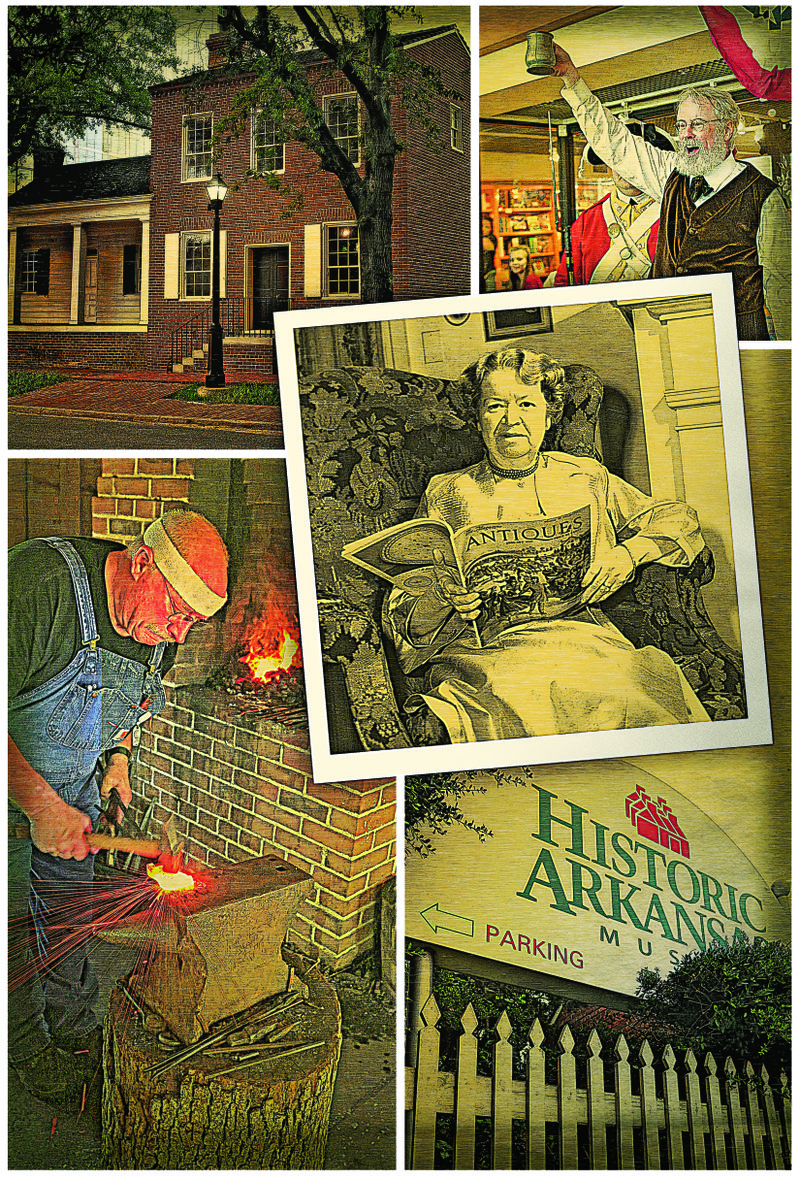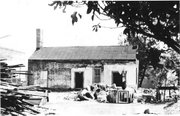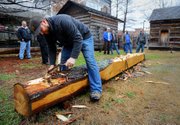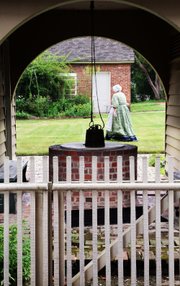One of Arkansas' foremost preservers of history makes history this week.
On Tuesday, the Historic Arkansas Museum will mark the 75th anniversary of its opening day, July 19, 1941, with a daylong celebration, 10 a.m.-6 p.m.
Historic Arkansas Museum 75th Anniversary Celebration
10 a.m.-6 p.m. Tuesday, Historic Arkansas Museum, 200 W. Third St., Little Rock. Tours of the grounds, 5 p.m. birthday cake and speeches. Refreshments include lemonade and the “George Bros. Historic Arkansas Ale” by Stone’s Throw Brewing, with music by Lark in the Morning
Free
(501) 324-9351
The festivities will include free tours of the grounds and its restored or replicated buildings, music by folk trio Lark in the Morning, period games, craft demonstrations and living-history re-enactments.
If you're 21 or older, you can sip on the "George Bros. Historic Arkansas Ale," a tribute beer that the folks at Stone's Throw Brewing concocted for the occasion. (There will also be lemonade for youngsters and teetotalers.) The official anniversary ceremony starts at 5 p.m., with a birthday cake and a variety of nuts and cheeses smoked in the on-the-grounds smokehouse in the historic Brownlee Back Yard.
Museum Executive Director Bill Worthen, who will mark 44 years at the museum's helm Dec. 1 and will retire at the end of the year, will say a few words -- he notes that as it's likely to be hot, he'll keep those to very few -- and dedicate the museum's 1850s Farmstead as the Parker Westbrook Farmstead in memory of the former museum commissioner and preservationist who died in November at age 89. Little Rock Mayor Mark Stodola will officially proclaim July 19 as Historic Arkansas Museum Day.
HERCULEAN EFFORT
In a three-year campaign starting in 1938, Louise Watkins Loughborough, socialite, civic activist and preservationist and a member of the Little Rock Planning Commission, beat the bushes, pounded the pavement, lobbied legislators and eventually convinced the federal Works Progress Administration to help her preserve a half block of Arkansas history.
Loughborough, born in 1881, frequently walked past Block 32 at Third and Cumberland streets, headed for her favorite candy store and/or the busy steamboat landing. By 1938, the neighborhood had fallen on hard times, something between a red-light district and a slum, and the dilapidated structures on the half block -- including the Hinderliter House, believed to be the oldest standing building in Little Rock (circa 1827, built as a tavern by one Jesse Hinderliter) -- were headed for demolition.
The country was still mired in the Great Depression and historical preservation was not yet a public priority.
That didn't stop Loughborough.
Worthen says she approached Floyd Sharp, the local director of the WPA, for help. Sharp, looking to get rid of her, fed her what museum officials say was an intentionally impossible number, $30,000, she'd have to come up with; on top of that, according WPA rules, she'd have to cobble together an association with a government entity.
"He dismissed her, but very lovingly," Worthen says. "He knew in his heart he was dismissing her -- forever."
If he thought Loughborough would stop there and go away, he didn't know her. She and lawyer husband, J. Fairfax "Fax" Loughborough, who worked for what eventually became the Rose Law Firm, had connections in the General Assembly. She printed up hand-out cards for public solicitations and made 30-second pitches to legislators, describing Little Rock as the "town of three Capitols" -- the current one, the Old State House and the Hinderliter Grog Shop, which, as reportedly the last meeting place of the Territorial Legislature, she labeled as the "Territorial Capitol."
It worked.
The Arkansas General Assembly, via Act 388 of 1939, created and supported with general revenues the Arkansas Territorial Capitol Restoration Commission, with Loughborough as its chairman. It also empowered her to collect moneys for the restoration of the half block, which she did through a private fundraising campaign.
Sharp had little choice but to provide labor and materials for the project. "He had to pull people off other jobs to fulfill what had been an offhand commitment," Worthen says with a chuckle. (No plaque credits the WPA or Sharp for their contributions to the museum's creation, Worthen admits. It's something he'll look into, he says.)
Loughborough, with the help of the commission, donations of furnishings and her friend, architect and artist Max Mayer, began restoration of the buildings. The museum opened as the Arkansas Territorial Capitol Restoration on July 19, 1941; Loughborough ran things for 20 years, until her health began to fail. She died in Little Rock on Dec. 10, 1962, and is buried in Mount Holly Cemetery.
'FORMIDABLE WOMAN'
Several living-history re-enactors have personated Loughborough over the years, Worthen says, mostly based on her letters.
"We knew the writing -- she left us with plenty of writings; the problem has been finding her voice," he says. "She was not perhaps as genteel and petite as she's been made out to be. She was actually a formidable woman."
Worthen met her a few times at her house in the company of his mother, the late philanthropist Mary Worthen, who died last year. "She was probably shorter than my mother, who was 5-foot-4," Bill Worthen recalls. "I had no idea I'd be spending the rest of my life in her shadow."
Mary Worthen was also part of the activities at the 1941 dedication. She was a tour guide stationed in the Hinderliter House.
Loughborough's successor, architect Edwin B. Cromwell, began expanding the site, adding the adjoining half-block to provide more space for programs and to cushion the original half-block from future development.
In December 1972, Worthen became the museum's first executive director and the museum hired its first professional staff. Worthen realized one of his early goals by gaining accreditation from the American Museums Association in 1981 -- it only took nine years -- while the museum adopted policies and procedures reflecting modern museum standards.
Also debuting under Worthen's administration: the museum's Living History program (Hinderliter and McVicar will be among the characters whom actors will portray at Tuesday's anniversary event); Giving Voice, dedicated to telling the stories of those enslaved on what is now museum property; and annual events, including the Frolic, Territorial Fair and Frontier Fourth of July.
RESTORED AND RE-MOVED
The Historic Arkansas Museum centers on three restored houses:
• The Brownlee House, which Worthen says is now the "go-to place for living history and 'domestic arts.'" It has been fully furnished and has a functioning kitchen, up to and including smoke coming out its chimney.
According to the Encyclopedia of Arkansas, Robert Brownlee was a stone mason who arrived in Little Rock in December 1837 with his friend and eventual neighbor, James McVicar, to work on the state Capitol on Markham Street now known as Old State House. They quarried the stone for, and by 1840 had set the foundations for, the building's east and west wings (the central section had been completed in 1836 in time for the inauguration of Arkansas' first elected governor, James S. Conway). Brownlee and brothers Thomas and James, who moved to Little Rock in 1842, built the two-room brick house in the neoclassic style for James.
• The McVicar House. McVicar, for a while superintendent at the state penitentiary, and Brownlee, when news came in 1848 that gold had been discovered in California, went west to make their fortunes. "Captain" McVicar came back after apparently failing to make a major strike, Worthen says. Brownlee married his Little Rock sweetheart, Annie Lamont, then moved with her back to a ranch in California's Napa Valley.
• The Hinderliter Grog Shop, which rough-and-ready Jessie Hinderliter built around 1827 on one of three lots he owned on the block. (After moving around some of the buildings on the site to give the former tavern some extra room, the McVicar House now sits on Lot 8 and the Brownlee House on Lot 9). It was an operating tavern, the Green Goose Beer Garden, even under the shadow of condemnation, until Loughborough bought it.
"There have to be a lot of stories there," Worthen says, noting that the building has been preserved, but unfortunately not the stories. Well, except one: In what Worthen calls "a frontier showdown," a patron, one William Russell, got into a fracas with Hinderliter, who killed him. A coroner's inquest returned a verdict of justifiable self-defense.
(The museum won't be serving the 75th anniversary beer in the grog shop. "Would that we were," Worthen says.)
Also on the grounds is a replica of the print shop of William E. Woodruff, who founded the Arkansas Gazette in 1819, rebuilt on the original site. "We did such a good job," Worthen says proudly. "Handmade bricks, oversized timber, blacksmith-made hardware. If William E. Woodruff walked in, maybe some of the furniture might be in different spots, but he'd recognize it right away."
On the north side of Second Street is the log-cabin farmstead, the museum's principal place for demonstrating period crafts. It includes three cabins, including the Plum Bayou Log House, and a rebuilt blacksmith shop.
The reception center opened in 2001, which coincided with the renaming of the Arkansas Territorial Restoration as the Historic Arkansas Museum. It's twice the size of the old one, with 10,000 square feet of exhibits, a theater, a hands-on history classroom, an entrance atrium with views of the historic grounds and other amenities (including a place to serve the 75th anniversary beer).
A special 75th anniversary exhibit opened in March and will remain up through the year. In the fall the museum is planning a special lecture and tour focusing on architect Max Mayer.
Museum officials recognize that high temperatures might be an issue for an outdoor event in July, but that's consistent with the era in which the buildings were first constructed (1820s-1850s) and also with what attendees at the 1941 opening of the Territorial Restoration would have endured.
"There was no air conditioning, so whatever they had, they took," Worthen says.
Style on 07/17/2016




